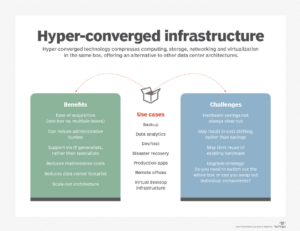Some of the links in this post are affiliate links. This means that if you click on the link and/or purchase an item, I will receive a small commission at no extra cost to you. Thank you for helping me earn a little coffee money and afford to create more great content.
What is Hyperconvergence?
Hyperconvergence, also called Hyperconverged Infrastructure or HCI, is a technology framework that combines storage, compute, networking, and hypervisor into a single solution in order to reduce complexity and increase scalability. Hyperconverged solutions are typically offered as prepackaged bundles of hardware and software, often referred to as nodes or blocks. Each node includes a predefined amount of memory, CPU, storage and network ports, along with a virtualization hypervisor. Capacity can be scaled linearly with the purchase of additional nodes.
Hyperconvergence defers from the legacy model of procuring storage, compute and networking separately, and often from different vendors. In a legacy environment, a customer might purchase a NetApp SAN, couple that with Supermicro servers, and then connect them together leveraging switches from Cisco. The customer may then choose to virtualize their servers using VMware’s virtualization offering. This might be called a best-of-breed approach.
While there are certainly benefits to procuring hardware and software that is viewed as best-of-breed for the use case, there are also drawbacks. First, customers must make the technology from various vendors work well together. There are compatibility issues on both the hardware and software side to consider. Often these issues rear their heads many years in the future, as code versions for the various products much meet differing requirements as code is advanced and upgrade.
There are also scalability challenges. If you need to expand your environment, this often means having to reach out multiple vendors in the future to procure more of each component. Hyperconvergence increases flexibility and improves scalability when compared to a legacy design.
Hyperconvergence technologies are typically productized and sold in two ways:
- Appliance
Appliance based HCI is sold as an all-in-one bundle. The hardware and software is sized for the use case, and then sold as an integrated units. Appliance-based hyperconverged technology is basically ready to use out of the box, lowering the time and complexity of deployment. Dell, HPE, and Cisco are leaders in the appliance-based hyperconvergence market.
- Software-Only
Software-Only HCI solutions provide the software needed for an HCI deployment but gives the customer the ability to choose hardware based on a compatibility matrix. This gives customers greater flexibility on hardware choices, and prevents vendor lock-in. The software-only HCI offerings provide reference architectures outlining which hardware solutions are compatible with their software, as well as use cases and deployment recommendations. VMware and Nutanix are two of the leading software players in the hyperconverged market.
Hardware providers have strategic partnerships with with hypercoverged software providers in order to offer a complete solution. Lenovo is an example. They integrate their hardware with software from Nutanix, VMware, or Microsoft Azure, to give customers the flexibility to deploy the best software solution for their needs.
Hyperconvergence Use Cases
Although hyperconvergence technology can be used for many use cases where storage, compute and network is required, it is ideally suited to workloads that scale linearly, meaning that storage, compute and networking grow at a similar rate. Some key use cases for HCI are as follows:
- Virtual Desktop Infrastructure (VDI)
One of the most compelling use cases for hyperconvergence is Virtual Desktop Infrastructure (VDI). With VDI users access their virtual machine, rather than a dedicated physical desktop, from a centralized host server. A VDI node is configured to host a specific number of desktops with predetermined requirements.
HCI is a perfect use case for VDI because VDI requirements have tendency to scale linearly. The more users on the VDI cluster, the more HCI nodes are required to support it. HCI infrastructure can be sized to fit the initial VDI requirements, and then can be scaled as VDI users are added. HCI’s use of SSD’s also provides the performance required for VDI, and prevents boot storms, when properly sized.
- Backup and Disaster Recovery
Backup and disaster recovery solutions are a great use case for hyperconvergence, as the virtualized infrastructure yields itself to an efficient use of backup and replication technologies. Most HCI solutions have native backup and replication capabilities. HCI solutions also integrate well with backup and replication technology solutions from Veeam, Zerto, VMware and others. HCI solutions integrate quickly and easily with cloud providers like Amazon Web Services, Microsoft Azure, Google, and others, making backing up and replicating to the cloud a simple proposition.
- Edge and Remote Office / Branch Office Computing
Edge computing and Remote Office / Branch Office (ROBO) deployments are great use cases for hyperconverged infrastructure. HCI gives customers the ability to deploy an all-in-one solution at the branch that includes storage, network, compute and hypervisor, eliminating the complexity of multiple vendors at a remote site.
Additionally, many edge and ROBO deployments start small but have the potential to scale up (or down) rapidly. HCI meets this need through the easy addition of more nodes. HCI can also be deployed at the edge or at a branch office simply and for a relatively low cost. The standardization of the HCI architecture also means it can be easily administered in locations that may lack dedicated IT staff.
- Test and Development Environments
Test and development environments often require programmers to be able to quickly spin up and spin down virtual machines on demand. They also require a level of performance that is similar to production deployments. HCI nodes provide developers with a complete, integrated solution, a native hypervisor, and a high level of performance ideal for test and development environments.
- File Storage
File storage needs are continuously growing. Many organizations are forced to keep files for years to meet compliance requirements. Hyperconverged infrastructure is incredibly scalable, and makes adding additional storage capacity as easy as adding additional nodes. Coupled with the backup and disaster recovery options available on HCI solutions, file storage is an excellent hyperconvergence use case.
Hyperconvergence Market Trends
The hyperconverged market continues to expand rapidly. Estimates expect the HCI market to grow from roughly $7 billion in 2021 to over $30 billion by 2028 for a combined annual growth rate (CAGR) of almost 25%. Growth in the data center, data protection, virtual desktop and other adjacent markets, as well as the benefits of HCI are key growth drivers.
There many vendors in the hyperconverged infrastructure space, and the number of new entrants into the space continues to grow, as the market expands. An outline of the major players in the space is as follows:
VMware
According to Statista’s mid-2021 report, VMware is the leader in HCI market share with roughly 39% market share. VMware’s vSAN (virtual storage area network) solution leverages their vSphere platform for storage management. VMware leverages their dominant position in the hypervisor space to integrate a best-in-class hypervisor with software-defined storage.
Nutanix is second in the space with about 23% market share. Nutanix has their own hypervisor, Nutanix AHV, but also allows customers to use a hypervisor of their choosing. Nutanix touts the openness, the ability to integrate with multiple cloud platforms, and simplicity of administration as primary selling points.
Huawei is third in the global HCI market with about 6% market share. The Chinese technology giant goes to market with their FusionCube platform. Huwawei touts performance, availability and simplified management as primary benefits.
Dell EMC is fourth with just under 6% market share. The have a number of HCI solutions including VxRail, VMware Cloud Foundation on VxRail, Dell EMC vSAN Ready Nodes, PowerFlex Dell EMC Solutions for Microsoft Azure, and their XC Family of appliances integrated with Nutanix. Customers benefit from the breadth of Dell EMC’s hyperconverged portfolio, and integrations with technology leaders like Microsoft, Nutanix and VMware.
HPE has about 4.5% global market share. HPE’s SimpliVity solution leverages HPE’s decades of experience in the storage area network market. Like their Nimble platform before it, SimpliVity touts its self-managing, self-healing and self-optimizing architecture that leverages predictive analytics and the InfoSight management platform.
Cisco has about 4% of the HCI market. Cisco’s HyperFlex platform is built on Cisco’s UCS sever platform. Cisco leads with performance, flexible integration with multicloud platforms, and deployment in edge computing scenarios as primary drivers.
Lenovo is a strong challenger. Their ThinkAgile HX series combines with Nutanix software for easy deployment and manageability. Their ThinkAgile SX series is designed for Azure cloud services. The ThinkAgile MX series is designed for Microsoft Azure stack HCI solutions. Finally, Lenovo’s ThinkAgile VX series is their VMware vSAN-based hyperconverged solution.
The rest of the HCI market is splintered between various players including Hypergrid, IBM, Microsoft, NetApp, Nutanix, Oracle, Pivot3, Scale, Stonefly, StorMagic, Stratoscale, and others. Various vendors lead with both hardware first, and software first approaches.
Conclusion
Hyperconvergence is a rapidly growing technology paradigm that adds significant value to storage and compute deployments. The benefits of the technology continue to expand as the technology evolves. Customers looking at making storage and compute infrastructure investments, should strongly considered hyperconverged infrastructure before investing in legacy platforms.




